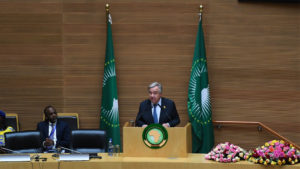UN chief Antonio Guterres has told world leaders to come up with concrete, realistic plans to boost climate action as greenhouse gas concentrations are driving global temperatures towards increasingly dangerous levels impacting millions of people.

United Nations: UN chief Antonio Guterres has told world leaders to come up with concrete, realistic plans to boost climate action as greenhouse gas concentrations are driving global temperatures towards increasingly dangerous levels impacting millions of people.
‘The State of the Global Climate’ report was launched Thursday by the World Meteorological Organization (WMO) and presents a grim picture of the accelerating physical signs and socio-economic impacts of the climate change across the world.
Secretary-General Guterres reiterated his call for action, underlining that the alarming conclusion of the report that climate change is accelerating, “proves what we have been saying: climate change is moving faster than our efforts to address it.”
The UN chief said he has convened the ‘Climate Action Summit’ on September 23 and he is telling leaders, “in September, please do not come with a speech; come with a plan.”
He said he is calling on leaders to come with concrete, realistic plans to put nations on a sustainable path once and for all.
“These plans must show how to enhance nationally determined contributions by 2020,” he said.
The report states that physical signs and socio-economic impacts of climate change are accelerating as record greenhouse gas concentrations drive global temperatures towards increasingly dangerous levels.
The report notes that 2018 was the fourth warmest year on record and 2015?2018 were the four warmest years on record as the long-term warming trend continues.
Ocean heat content is also at a record high and global mean sea level continues to rise, while Arctic and Antarctic sea-ice extent is well below average.
Average global temperature reached approximately 1?C above pre-industrial levels and nations are not on track to meet climate change targets and rein in temperature increases, the report said.
“2018 saw new records for ocean heat content in the upper 700 metres (data record started in 1955) and upper 2000 metres (data record started in 2005), topping the previous record set in 2017. More than 90 per cent of the energy trapped by greenhouse gases goes into the oceans and ocean heat content provides a direct measure of this energy accumulation in the upper layers of the ocean,” the report added.
Further, it said sea level continues to rise at an accelerated rate. “Global Mean Sea Level (GMSL) for 2018 was around 3.7 millimetres higher than in 2017 and the highest on record,” it said.
In 2018, most of the natural hazards which affected nearly 62 million people were associated with extreme weather and climate events.
Floods continued to affect the largest number of people, more than 35 million, according to an analysis of 281 events recorded by the Centre for Research on the Epidemiology of Disasters (CRED) and the UN International Strategy for Disaster Risk Reduction, the report said.
The report said that millions continue to be displaced due to impact of climate change.
Out of the 17.7 million Internally Displaced Persons (IDPs) tracked by the International Organization for Migration, over two million people were displaced due to disasters linked to weather and climate events as of September 2018.
Drought, floods and storms (including hurricanes and cyclones) are the events that have led to the most disaster-induced displacement in 2018. President of the General Assembly, Maria Fernanda Espinosa, said she had pledged throughout her time in office there was a need for “a holistic understanding of the socio-economic consequences of increasingly intense extreme weather on countries around the world”, adding that the report “makes an important contribution to our combined international action to focus attention on this very critical problem.”
It was “really not good news” she told reporters during a press conference that carbon dioxide emissions had jumped from 1.6 per cent in 2017, to passing the 2.7 per cent emissions growth, during 2018.
“We need to act, and to act now. The numbers and data are extremely worrisome?We are capable, we have the science, we have the knowledge, we have the tools in hand” to push back on global warming, she added.
The WMO said that the temperature rise last year, came despite the agreement by the international community in December 2015 in Paris, to curb carbon dioxide and other greenhouse gas emissions, and to limit global temperature rise to well below 2C.
“The time remaining to achieve commitments under the Paris Agreement is quickly running out,” said WMO Secretary-General, Petteri Taalas.
Outlining the report’s key findings, Taalas warned of record greenhouse gas concentrations last year, that drove global temperatures towards increasingly dangerous levels.
According to WMO, carbon dioxide levels were at 357 parts per million (ppm) in 1994, rising to 405.5 ppm in 2017.
Taalas also described “striking” evidence of record warming from 2015 to 2018, increasing sea-level rise and the loss of sea ice in both northern and southern polar regions.
Earlier, the General Assembly held a High-Level meeting on climate change and sustainable development, including panel discussions on synergies between the two, and how the two agendas can be brought together in terms of concrete action.


